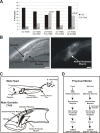Sensory perception of food and insulin-like signals influence seizure susceptibility
- PMID: 18604269
- PMCID: PMC2432499
- DOI: 10.1371/journal.pgen.1000117
Sensory perception of food and insulin-like signals influence seizure susceptibility
Abstract
Food deprivation is known to affect physiology and behavior. Changes that occur could be the result of the organism's monitoring of internal and external nutrient availability. In C. elegans, male mating is dependent on food availability; food-deprived males mate with lower efficiency compared to their well-fed counterparts, suggesting that the mating circuit is repressed in low-food environments. This behavioral response could be mediated by sensory neurons exposed to the environment or by internal metabolic cues. We demonstrated that food-deprivation negatively regulates sex-muscle excitability through the activity of chemosensory neurons and insulin-like signaling. Specifically, we found that the repressive effects of food deprivation on the mating circuit can be partially blocked by placing males on inedible food, E. coli that can be sensed but not eaten. We determined that the olfactory AWC neurons actively suppress sex-muscle excitability in response to food deprivation. In addition, we demonstrated that loss of insulin-like receptor (DAF-2) signaling in the sex muscles blocks the ability of food deprivation to suppress the mating circuit. During low-food conditions, we propose that increased activity by specific olfactory neurons (AWCs) leads to the release of neuroendocrine signals, including insulin-like ligands. Insulin-like receptor signaling in the sex muscles then reduces cell excitability via activation of downstream molecules, including PLC-gamma and CaMKII.
Conflict of interest statement
The authors have declared that no competing interests exist.
Figures





Similar articles
-
C. elegans Males Integrate Food Signals and Biological Sex to Modulate State-Dependent Chemosensation and Behavioral Prioritization.Curr Biol. 2020 Jul 20;30(14):2695-2706.e4. doi: 10.1016/j.cub.2020.05.006. Epub 2020 Jun 11. Curr Biol. 2020. PMID: 32531276 Free PMC article.
-
Feeding state regulates pheromone-mediated avoidance behavior via the insulin signaling pathway in Caenorhabditis elegans.EMBO J. 2018 Aug 1;37(15):e98402. doi: 10.15252/embj.201798402. Epub 2018 Jun 19. EMBO J. 2018. PMID: 29925517 Free PMC article.
-
Food deprivation attenuates seizures through CaMKII and EAG K+ channels.PLoS Genet. 2007 Sep;3(9):1622-32. doi: 10.1371/journal.pgen.0030156. Epub 2007 Jul 30. PLoS Genet. 2007. PMID: 17941711 Free PMC article.
-
The effects of transient starvation persist through direct interactions between CaMKII and ether-a-go-go K+ channels in C. elegans males.Neuroscience. 2011 Feb 23;175:1-17. doi: 10.1016/j.neuroscience.2010.12.002. Epub 2010 Dec 9. Neuroscience. 2011. PMID: 21145946 Free PMC article.
-
Insulin/insulin-like growth factor signaling in C. elegans.WormBook. 2013 Dec 26:1-43. doi: 10.1895/wormbook.1.164.1. WormBook. 2013. PMID: 24395814 Free PMC article. Review.
Cited by
-
Neuroendocrine gene expression coupling of interoceptive bacterial food cues to foraging behavior of C. elegans.Elife. 2024 Jan 17;12:RP91120. doi: 10.7554/eLife.91120. Elife. 2024. PMID: 38231572 Free PMC article.
-
Molecular and sensory basis of a food related two-state behavior in C. elegans.PLoS One. 2009 Oct 23;4(10):e7584. doi: 10.1371/journal.pone.0007584. PLoS One. 2009. PMID: 19851507 Free PMC article.
-
A cholinergic-regulated circuit coordinates the maintenance and bi-stable states of a sensory-motor behavior during Caenorhabditis elegans male copulation.PLoS Genet. 2011 Mar;7(3):e1001326. doi: 10.1371/journal.pgen.1001326. Epub 2011 Mar 10. PLoS Genet. 2011. PMID: 21423722 Free PMC article.
-
SIR-2.1 integrates metabolic homeostasis with the reproductive neuromuscular excitability in early aging male Caenorhabditis elegans.Elife. 2014 Apr 22;3:e01730. doi: 10.7554/eLife.01730. Elife. 2014. PMID: 24755287 Free PMC article.
-
Sex-specific, pdfr-1-dependent modulation of pheromone avoidance by food abundance enables flexibility in C. elegans foraging behavior.Curr Biol. 2021 Oct 25;31(20):4449-4461.e4. doi: 10.1016/j.cub.2021.07.069. Epub 2021 Aug 25. Curr Biol. 2021. PMID: 34437843 Free PMC article.
References
-
- Kaeberlein TL, Smith ED, Tsuchiya M, Welton KL, Thomas JH, et al. Lifespan extension in Caenorhabditis elegans by complete removal of food. Aging Cell. 2006;5:487–494. - PubMed
-
- Bough KJ, Valiyil R, Han FT, Eagles DA. Seizure resistance is dependent upon age and calorie restriction in rats fed a ketogenic diet. Epilepsy Res. 1999;35:21–28. - PubMed
Publication types
MeSH terms
Substances
Grants and funding
LinkOut - more resources
Full Text Sources
Medical
Miscellaneous

